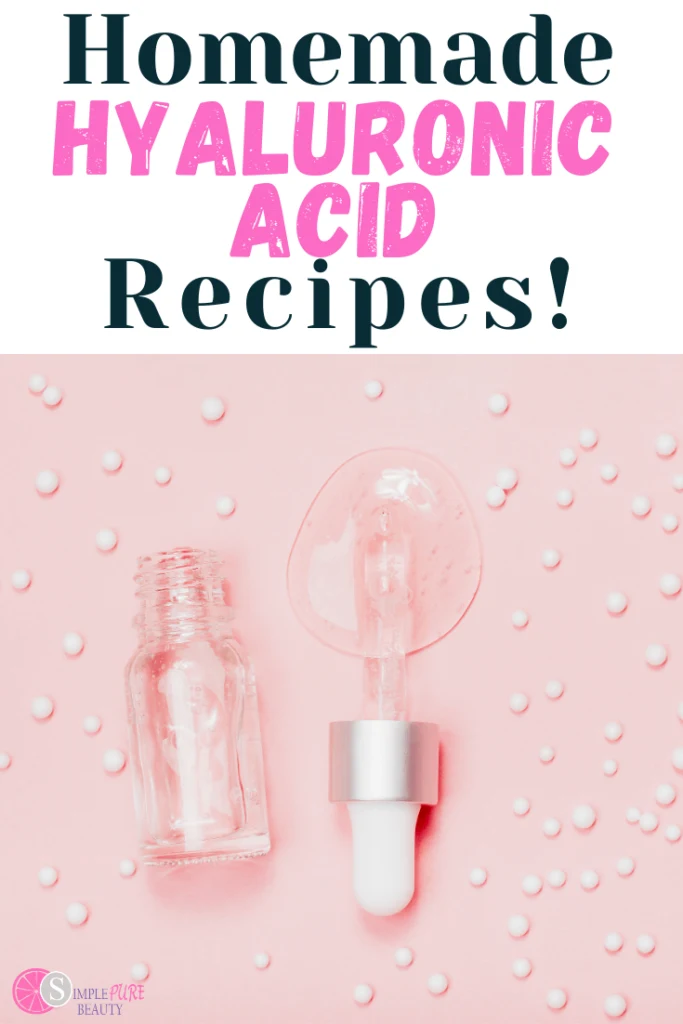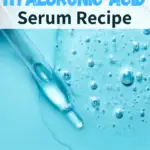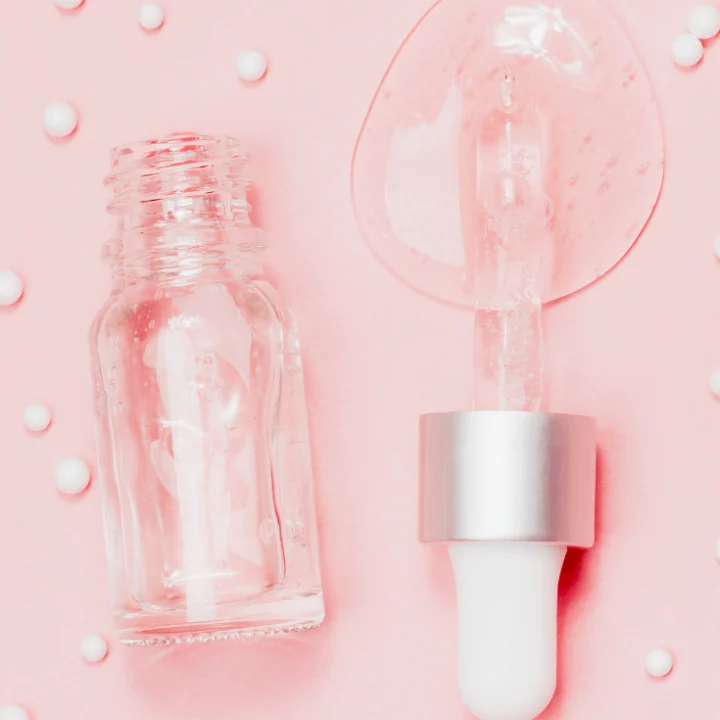DIY Hyaluronic Acid Serum is so easy to make and its ability to help your skin maintain moisture is unmatched.
Hyaluronic acid is all of the rave in anti-aging skincare. Unfortunately as we get older, our skin loses hyaluronic acid.
When hyaluronic acid is applied to the skin, it increases the moisture level in the skin and has been shown to reduce the signs of aging.

What is Hyaluronic Acid?
Contrary to the second part of its name, hyaluronic acid is not an actual “acid” per se. It will not burn your skin. Do not let the name scare you away because hyaluronic acid can be your skin’s best friend.
Hyaluronic acid is a natural glycosaminoglycan (polysaccharides that are an important component of connective tissues) that is naturally occurring in our bodies, with half of it being found in our skin.

It plays an integral role in maintaining and regulating moisture within our tissues. As we age the amount of hyaluronic acid production gradually slows down resulting in fine lines and wrinkles. Hyaluronic acid can retain moisture up to 1000 times its own weight in water giving you a more youthful look. (source)
Can Hyaluronic Acid be Used as a Serum?
Hyaluronic acid, on its own cannot be used as a serum but all you need are a few ingredients to make your own DIY Hyaluronic Acid Serum.
Can I Use Hyaluronic Acid Every Day?

Hyaluronic acid serum is applied topically to damp skin before you apply your moisturizer. It can also be used in conjunction with other face creams such as sunscreen or your daily moisturizer.
Should You Use Hyaluronic Acid Morning or Night?
Used regularly as part of your skincare regimen, hyaluronic acid will help plump up your skin decreasing the appearance of fine lines and wrinkles. It is safe to use daily, but for people with the most sensitive skin, using in the morning and night may be a bit too much.
Hyaluronic acid basically acts like a sponge on your skin by attracting and retaining moisture due to its water-attracting properties. (source)
Should You Use Hyaluronic Acid & Vitamin C Serum Together?
These 2 powerhouse ingredients absolutely can be used together. For even better anti-aging results, you can whip up this DIY Vitamin C Serum Recipe and use it alongside your Hyaluronic Acid Serum.
How to Make DIY Hyaluronic Acid Serum?
It is no surprise that hyaluronic acid is a popular ingredient in the beauty industry with many beauty brands adding hyaluronic acid into their creams and serums.
The downside is that some brands only add a small amount of hyaluronic acid into their serums and some even mix it with toxic chemicals.
You can make your very own diy hyaluronic acid serum from home with the same great benefits of the more expensive brands.
To make your own hyaluronic acid serum, you will need to purchase some high quality Hyaluronic Acid Powder.
High Molecular Weight or Low Molecular Weight Hyaluronic Acid?
There is some debate as to whether you should use a high molecular weight (or low molecular weight hyaluronic acid for your skincare recipes. Some sources think that low molecular weight HA penetrates better into the skin's surface.
While others think it actually causes inflammation in the skin. I would suggest doing your research on this topic if you are concerned at all. You can also add both to your serum if you like.
DIY Hyaluronic Acid Serum Ingredients
You will need a few ingredients to make your own serum including:
Hydrosol or Floral Water – A few good options would be Lavender or Rose Hydrosol.
Distilled Water – If you don't have floral water, you can just add more distilled water.
Vegetable Glycerin – Vegetable glycerin is a humectant that helps draw water to the skin. We will be using our glycerin to help disperse the hyaluronic acid into our serum as well.
Xanthan Gum – Xanthan gum is a natural gum polysaccharide that is used as a thickener.
Hyaluronic Acid – I have chosen a high molecular weight hyaluronic acid for this recipe, but as we covered before, you can include both high and low in your recipe.
Dermosoft Eco 1388 – Because this is water based, we will be adding a preservative.
This preservative provides outstanding broad spectrum antimicrobial activity. It is a little weak against yeast. You could add an additional preservative to boost the yeast protection, but I recommend storing your serum in a bottle with a pump top to prevent any outside contamination.
In the past I've recommended Geogard ECT as a broad spectrum preservative for water based products because it claims to be water soluble. But unfortunately the Benzyl Alcohol isn't completely water soluble which can lead to skin sensitization issues, which we don't want.
This formula calls for 1 gram of Dermosoft 1388 Eco.
I recommend purchasing a jewelry scale to accurately add preservatives to your formulations.
I have included a conversion as well, if you don't have a jewelry scale. You can add 3/16 tsp of the preservative Dermosoft 1388 Eco.
If you don't have measuring spoons this small, you can find them on Amazon here. Let's get to the recipe!
Be sure to pin this post and share it!
















Veronica Hasbrouck
Wednesday 21st of July 2021
What if my recipe turned out a bit “jellyish”?
Mindy Benkert
Tuesday 27th of July 2021
Hi Veronica, if your serum is too "jellyish" for your liking, you can try reducing the amount of xanthan gum you are using.
Jodi
Tuesday 26th of January 2021
How do you test the ph in this
Mindy Benkert
Tuesday 26th of January 2021
Hi Jodi, you can check out the Checking the pH Tutorial of Skincare Products post here.
Debra
Tuesday 26th of January 2021
One quick comment. It would help me to make a more consistent product if you could also include the grams measurements to your recipes. Thanks so much!
Mindy Benkert
Tuesday 26th of January 2021
Hi Debra, that is definitely something I plan on doing moving forward. :)
hems
Sunday 24th of January 2021
How serum should be used? Is it beneficial to apply on the face before applying my homemade anti aging cream?
Mindy Benkert
Tuesday 26th of January 2021
Hems, yes, you would apply this to a damp face before applying your anti-aging cream. :)
Ayesha
Saturday 1st of February 2020
Hi dear plzz answer me. Can we add germall plus (preservative) in this HA serum instead of GSE? Somebody told me that germall plus is skin friendly preservative nd can increase the shelf life of HA serum upto 2 years . So plz tell me if you know about this preservative? Its pros nd cones? How much can i add if I follow your above recepie of making HA serum.